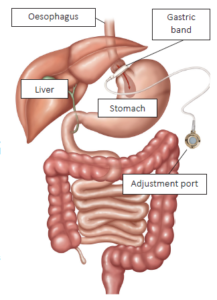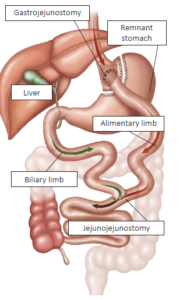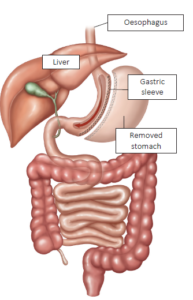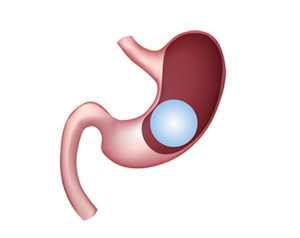Surgical procedures
Gastric band

The gastric band is a silicone band which is fitted by keyhole (laparoscopic) surgery around the top of the stomach. Once it has been in place for 4 to 6 weeks, and the wound has healed, the band can be adjusted with a needle via the access port by adding or removing sterile water. Sometimes, depending on the amount of swelling, a small amount of sterile water is added at the time of surgery. Depending on how well you are and where you live, this procedure is usually performed as a day case or involves one overnight hospital stay.
Roux-en-Y gastric bypass

The procedure is known as a Roux-en-Y gastric bypass and is performed as a keyhole operation. A small stomach pouch (about the size of an egg) is made and joined to the small bowel downstream of the remaining stomach and duodenum (first section of small bowel). The pouch is no longer attached to the rest of the stomach, which is known as the remnant stomach, but the digestive juices from this filter in to where the small bowel is re-joined to the duodenum (at the jejunojejunostomy). Depending on how well you are and where you live, this procedure usually involves a stay in hospital for one to two nights.
Sleeve gastrectomy

The sleeve gastrectomy is performed as a keyhole operation. The stomach is made into a narrow tube and the remaining part (about 75%) is removed. The stomach is reduced in size to about 25% of its original size, so you will be producing less gastric acid but the digestive process is not altered. The stomach resembles a banana in shape, being a narrow gastric sleeve. Depending on how well you are and where you live, this procedure usually involves a stay in hospital for one to two nights.
Intragastric balloon
The surgeon may suggest you have a gastric balloon inserted. This is a silicone balloon which is fitted in the stomach via the mouth as a day case under light general anaesthetic. It is sometimes used to help a patient lose weight to make one of the other operations such as gastric bypass safer. It stays in place for six months. On average, patients lose 10 to 20% of their excess weight with the balloon.


